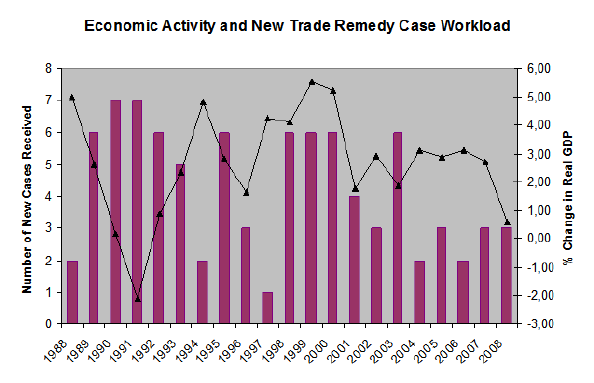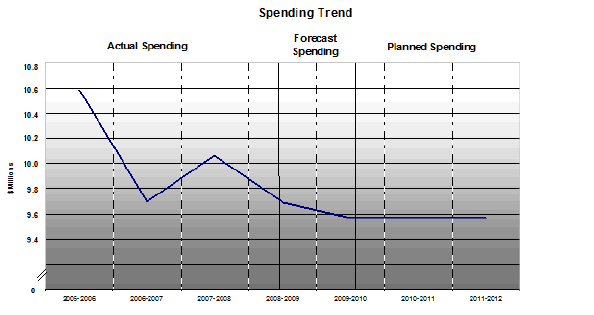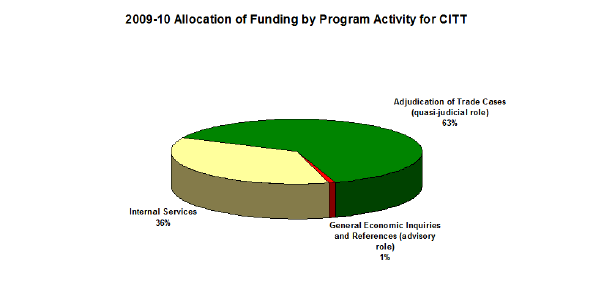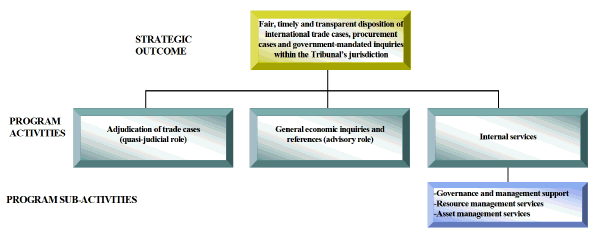Common menu bar links
Breadcrumb Trail
ARCHIVED - Canadian International Trade Tribunal
 This page has been archived.
This page has been archived.
Archived Content
Information identified as archived on the Web is for reference, research or recordkeeping purposes. It has not been altered or updated after the date of archiving. Web pages that are archived on the Web are not subject to the Government of Canada Web Standards. As per the Communications Policy of the Government of Canada, you can request alternate formats on the "Contact Us" page.
CHAIRPERSON'S MESSAGE
I am pleased to present the 2009-2010 Report on Plans and Priorities (RPP) for the Canadian International Trade Tribunal (the Tribunal).
The Tribunal's mandate is to provide the fair, transparent, timely and effective disposition of international trade cases, government procurement reviews and other matters in various areas of the Tribunal's jurisdiction. The Tribunal conducts inquiries into complaints relating to unfair trade (i.e. dumping and subsidizing), requests for protection from rapid increases in imports (safeguards) and complaints regarding federal government procurement. The Tribunal hears appeals from decisions of the Minister of National Revenue and the Canada Border Services Agency (CBSA) under the Excise Tax Act and the Customs Act respectively. In its advisory role, the Tribunal undertakes general economic inquiries and tariff references for the Minister of Finance or the Governor in Council. In so doing, the Tribunal contributes to Canada's competitiveness and a fair and secure marketplace.
The trade remedies program administered by the Tribunal is designed to protect Canadian businesses and their employees from the injurious effects of unfairly traded imports, in line with Canada's international rights and obligations. Case activity under this program is countercyclical, meaning that cases are up when the economy is down. With the current uncertainty in world financial markets and the depth of the downturn in the world economy, case activity is expected to increase. The Tribunal is monitoring this situation carefully, ensuring that priority is given to its core business, that its processes and procedures are the most efficient possible and that resources are in place to handle the increased activity.
The main priority for the Tribunal for 2009-2010 continues to be to ensure the fair, timely and effective disposition of cases. In 2009-2010, the supporting priority remains that of continuous improvement, as the Tribunal targets initiatives under three broad categories: investment in its people, sound management practices and improved service delivery.
In particular, the Tribunal will continue to invest in its people by encouraging learning and skills development on the part of all employees. Sound management practices will be further reinforced through the integration of the Management Accountability Framework into the Tribunal's day-to-day management practices. In addition, it will develop a more integrated system to track all case work and streamline case management and workflow. Through these initiatives, the Tribunal is committed to advancing government priorities by enhancing its services to Canadians, improving its accountability and ensuring the transparency of its operations.
The original version was signed by:
André F. Scott
Chairperson
SECTION I—TRIBUNAL OVERVIEW
Raison d'être
The purpose of the Tribunal is to support the economic objectives of the Government of Canada by contributing to the existence of a fair, accessible and transparent trade and procurement regime in Canada.
Responsibilities
The Tribunal was established in December 1988 under the Canadian International Trade Tribunal Act (CITT Act). It acts as an independent, investigative and quasi-judicial decision-making body that reports to Parliament through the Minister of Finance. The Tribunal also derives authority from the Special Import Measures Act (SIMA), the Customs Act and the Excise Tax Act. The Tribunal operates in one central location in Ottawa, Ontario.
Under SIMA, the Tribunal conducts inquiries into whether dumped and/or subsidized imports have injured Canadian manufacturers. Pursuant to the Customs Act, the Excise Tax Act and SIMA, the Tribunal is empowered to deal with appeals from decisions of the Minister of National Revenue and the Canada Border Services Agency (CBSA) on various excise and customs matters. With the implementation of the North American Free Trade Agreement (NAFTA), the Tribunal's mandate was expanded to include reviewing bid challenges on federal government procurement matters. The Tribunal has also been designated as the bid challenge authority under the Agreement on Internal Trade and the World Trade Organization (WTO) Agreement on Government Procurement. Under the CITT Act, the Tribunal inquires into and provides advice on such economic, trade, commercial and tariff issues as are referred to the Tribunal by the Governor in Council or the Minister of Finance. It also undertakes safeguard inquiries under the CITT Act and is empowered, on complaint by an interested party or as directed by the Government, to carry out safeguard inquiries into rapid increases in foreign imports (including through special procedures for imports specifically from the People's Republic of China) and to formulate recommendations to the Government for dealing with such imports.
Strategic Outcome and Program Activity Architecture
The chart bellow illustrates the Tribunal's complete framework of program activities and program sub-activities.
Planning Summary
| 2009-2010 | 2010-2011 | 2011-2012 |
|---|---|---|
| 9,530 | 9,530 | 9,530 |
| 2009-2010 | 2010-2011 | 2011-2012 |
|---|---|---|
| 77 | 77 | 77 |
| Performance Indicators | Targets |
|---|---|
| Tribunal decisions overturned by the Federal Court of Appeal or international appeal bodies | Less than 2 percent of all decisions rendered are overturned by the Federal Court of Appeal or international appeal bodies. |
| Soundness of the Tribunal's decisions—Overturned decisions with "due process" | Less than 1 percent of all decisions rendered are overturned by the Federal Court of Appeal or international appeal bodies on judicial review dealing specifically with "due process". |
| Tribunal notices, decisions and guidelines are accessible to the public. | All notices, decisions and guidelines for all areas of its mandate and practice notices are accessible to the public through the Tribunal's Web site, the Canada Gazette and/or MERX (Canada's electronic tendering system). |
| Decisions are issued within statutory deadlines. | All decisions are issued within the statutory deadlines. |
| Appeal decisions are issued within internal deadlines. | Seventy percent of decisions on appeals are issued within internal deadlines. |
| Recommendations meet the terms of reference and provide requested information. | All recommendations and reports meet the terms of reference and provide requested information. |
| Reports, determinations and recommendations are published within Government-mandated deadlines. | All reports and recommendations to the Government or the Minister of Finance are published within the statutory deadlines. |
| Program Activity1 | Forecast Spending 2008-2009 |
Planned Spending | Alignment to Government of Canada Outcomes | ||
|---|---|---|---|---|---|
| 2009-2010 | 2010-2011 | 2011-2012 | |||
| Adjudication of Trade Cases (quasi-judicial role) | 6,103 | 6,071 | 6,071 | 6,071 | Fair and secure marketplace |
| General Economic Inquiries and References (advisory role) | 97 | 88 | 88 | 88 | Fair and secure marketplace |
| Internal Services | 3,488 | 3,371 | 3,371 | 3,371 | |
| Total | 9,688 | 9,530 | 9,530 | ||
Contribution of the Tribunal's Priorities to its Strategic Outcome
| Operational Priorities | Type | Link to Strategic Outcome | Description |
|---|---|---|---|
| Process Cases Within Legislative Deadlines and Maintain Quality Standards | Ongoing | Strategic Outcome 1 |
The primary objective is to ensure that statutory deadlines are met and that the quality of the Tribunal's findings, determinations and recommendations is not compromised, particularly during peaks in workload. To accomplish this, the Tribunal will focus on effective workforce planning, which includes selecting and prioritizing initiatives that will optimize resources and operational efficiencies. |
| Improve Service Delivery | Ongoing | Strategic Outcome 1 |
Continuous improvement in service delivery remains a priority for the Tribunal. The focus will be on process improvement and ensuring the continuity of Information Technology (IT) services, both for internal users and for outside parties and their counsel. In its effort to optimize resources and operational efficiencies, the Tribunal will continue to review and streamline its processes for appeal cases and, in cooperation with the CBSA, for expiry reviews. It will also continue to develop an IT Strategy, an IT Architecture Plan and the ToolKit system (electronic compilation of the administrative record). |
| Management Priorities | Type | Link to Strategic Outcome | Description |
|---|---|---|---|
| Invest in Its People | Ongoing | Strategic Outcome 1 |
To meet its challenges, the Tribunal has adopted a human resources strategy that incorporates the recruitment, the development and the retention of its expert staff. This comprehensive approach will focus on professional development, in-house training material, succession planning and continuous learning to keep its employees' skills current. The Tribunal relies on the strength of its employees to maintain its tradition of excellence. In order to attract and retain a diverse and skilled workforce, it bases its human resources strategy on encouraging learning and skills development on the part of all employees. |
| Sound Management Practices | Ongoing | Strategic Outcome 1 |
Promoting transparency and supporting overall government-wide management accountability priorities, including the Management Accountability Framework (MAF) and the commitments introduced under the new Federal Accountability Act, continue to be priorities for the Tribunal. The plans under these priorities include the development of a more-integrated system to track all case work and to improve and streamline case management and workflow. The Tribunal will maintain its risk-based audit plan and will address areas of highest risk and significance. It will also address any areas of concern resulting from its MAF assessment. The Tribunal will also be implementing a workshop on values and ethics for all its employees. |
Risk Analysis
Operating Environment
Looking ahead to 2009-2010, a number of external factors are expected to affect the number and mix of cases before the Tribunal. These factors relate to the state of the world and Canadian economies, the trade environment and government actions.
Currently, there are three major challenges facing the Canadian economy and the trade environment. First, the ongoing situation in global financial markets has resulted in a significant loss of wealth and much tighter credit conditions, adversely affecting investment and profits. Second, the economic slowdown in the United States and other key economies has dampened demand and sharply reduced prices for Canadian exports, slowing profits and income growth in Canada. Third, the current slowing and likely contraction of the Canadian economy in 2009 is intensifying competition in the domestic market between domestically produced goods and imports.
While the outcome of the current economic situation is uncertain, it seems likely that it will lead to an increase in trade remedy cases. During the recession in the early 1990s, the Tribunal experienced a doubling in the number of new trade remedy complaints, and the increased caseload was sustained for a couple of years beyond the downturn (see Figure 1). Although Canada avoided a recession during the economic downturns in 1995-96 and 2000-2001, the number of new trade remedy cases in the two periods either increased from previous levels or remained relatively high. In light of the current and foreseeable financial and economic situation and the caseload experienced during similar events in the past, the Tribunal is forecasting a significant and sustained increase in the intake of new cases for 2009-2010 and beyond.

On the international stage, the Tribunal will continue to provide expert advice to the Government in support of the Doha Development Round of negotiations in Geneva, Switzerland, the current trade-negotiation round of the WTO.
As in recent years, government-wide initiatives focussed on accountability and transparency in general and procurement in particular have raised awareness among potential bidders about their rights and the possibility of redress at the Tribunal. Communications initiatives of the Procurement Ombudsman may bring about even more awareness about the rights of bidders and generate even more complaints. Looking forward, the number of procurement cases will likely be higher, as will complaints accepted for inquiry. Additional resources were allocated to this activity in the past couple of years.
The Tribunal supports the government-wide initiatives on accountability and transparency. As a small agency, it has sought innovative and efficient ways to deliver fully on these initiatives. The Tribunal has, for example, partnered with other small agencies in the Human Resources Co-op to help meet human resources initiatives, created special in-house teams to respond to planning and review initiatives and engaged outside experts on a temporary basis to provide advice on risk management and to conduct financial and business-process audits. The Tribunal expects to continue to expend significant effort participating in these initiatives in the year ahead.
The Tribunal foresees no significant shift in the number of appeals and textile reference cases in 2009-2010 compared to recent years.
With all the above factors taken into consideration, the Tribunal believes that the overall workload will increase substantially in the coming years. Increased activity in trade remedy cases is of a particular concern. The trade remedies program administered by the Tribunal is designed to protect Canadian businesses and their employees from the injurious effects of unfairly traded imports, in line with Canada's international rights and obligations. However, they are highly resource-intensive activities for the Tribunal. Since the stakes are high for the Canadian economy, international trade agreements and Canadian law impose an obligation upon the Tribunal to inquire deeply into the matters at issue, demanding extensive research and the best available analysis to support informed decision making. The Tribunal is currently reviewing its operating procedures for these cases with the hope of finding more economies and efficiencies.
Challenges and Key Risks
The Tribunal faces risks and challenges that could impact on the organization's ability to achieve its mandate. As part of the planning process, a risk assessment is conducted, therefore, managers are aware of these risks and challenges. They are expected to take appropriate action to mitigate the risks while ensuring the delivery of the Tribunal's mandate. Risks and related strategies are also discussed at regular Executive Committee meetings.
In delivering on its mandate, the Tribunal faces several key human resources and IT challenges in the coming year. The Tribunal is addressing these challenges as management priorities.
Over the course of an in-depth strategic review conducted with the Treasury Board last year, the Tribunal identified potential savings from the better alignment of resources to workload and efficiency gains. The Tribunal's operational funding was reduced in line with the proposed savings. In response, the Tribunal has been transitioning to a new business model in order to adjust to a reduced workforce. However, recent unanticipated events in financial markets and the expectation of a deep and prolonged downturn in the global, U.S. and Canadian economies have since required the Tribunal to revise its estimated caseload upward for 2009-2010 and beyond. This higher-than-expected caseload is likely to place additional pressures on the Tribunal to deliver on its trade remedies and other mandates. The following are the three key risks identified in the 2009-2010 planning session.
- 1. Maintaining the Quality of Decisions and Meeting Legislative Timelines With a Reduced Workforce: To continue to effectively deliver on its mandate and provide quality services with a reduced workforce, the Tribunal will be focussing on strategies to improve case processes and will invest in its people. However, due to the depth of the economic downturn and expected caseload increase, the Tribunal will also have to monitor closely its level of resources. Flexibility, innovation and particular attention to human resources planning, business planning and priority setting will be required. The Tribunal needs to ensure that the right level of resources, mix of people, processes and technology are in place to support sound decision making, while meeting legislative timelines.
- 2. Maintaining the Quality of Decisions and Meeting Legislative Timelines in Peak Periods: A number of factors impact on the Tribunal's ability to act in a responsive manner. First, workload is externally driven, and the Tribunal has no ability to affect the volume of its intake of cases. Secondly, there is uncertainty in predicting the size and complexity of the workload. Unpredictable case demands and case bunching may continue to be challenges. There has also been a change in the number and mix of cases before the Tribunal. An underlying concern is that a higher-than-expected caseload, or a sudden increase in the number of cases, could affect the Tribunal's ability to process cases within prescribed deadlines.
- 3. Knowledge Transfer: The Tribunal's work requires specialized skills and knowledge, which are acquired over a number of years from training and experience, and includes key elements, such as judgment, values and insights. Knowledge of this type is not easily replaced. The challenge to replace highly specialized employees is made more difficult by a tight labour market and stiff competition from the private sector. The Tribunal is also expecting a number of possible departures due to retirements over the next five years. As the Tribunal is a small organization, the impact of staff turnover can be significant and create challenges in terms of resources. Maintaining continuity of the Tribunal's corporate knowledge requires a sustained focus on training and development, recruitment, retention and succession planning. Trainees and junior staff require timely access to orientation and training programs to expedite the knowledge transfer process.
Expenditure Profile
| Actual Spending | Forecast Spending | Planned Spending | |||||
|---|---|---|---|---|---|---|---|
| 2005-2006 | 2006-2007 | 2007-2008 | 2008-2009 | 2009-2010 | 2010-2011 | 2011-2012 | |
| Net Cost of Program | 10,581 | 9,700 | 10,061 | 9,688 | 9,530 | 9,530 | 9,530 |
For the 2005-2006 to 2008-2009 periods, total spending includes all parliamentary appropriation: Main Estimates, Supplementary Estimates and Treasury Board Vote 15, and carry-forward adjustments. For the 2009-2010 to 2011-2012 periods, total spending corresponds to planned spending. Supplementary funding and carry-forward adjustments are unknown at this point and are therefore not reflected. Below is a graph showing the spending trend since 2005-2006.

The fluctuations in spending and planned spending since 2005-2006 can be explained by the three following events:
- In 2005-2006, the Tribunal worked on two major economic, trade and tariff references in addition to its normal caseload.
- In 2007-2008, the Tribunal replaced its aging hearing room audio system for a total actual cost of nearly $340,000.
- Starting in 2008-2009, the Tribunal's budget has been reduced by $700,000 to $9.5 million as a result of the 2007 Strategic Review.
The figure below displays the percentage allocation of the Tribunal's funding by program activity for 2009-2010.

| Vote or Statutory Item | Truncated Vote or Statutory Wording | 2009-2010 Main Estimates |
2008-2009 Main Estimates* |
|---|---|---|---|
| 20 | Program Expenditures | 8,379 | 8,984 |
| (S) | Contributions to Employee Benefit Plans | 1,151 | 1,168 |
| Total Tribunal | 9,530 | 10,152 | |
* Note: The Tribunal's budget was reduced by $700,000 as part of the 2007 Strategic Review. Although the budget reduction was in effect at the beginning of 2008-2009, it will not be officially reflected in the budget until the Supplementary Estimates (C) are tabled in early 2009.

